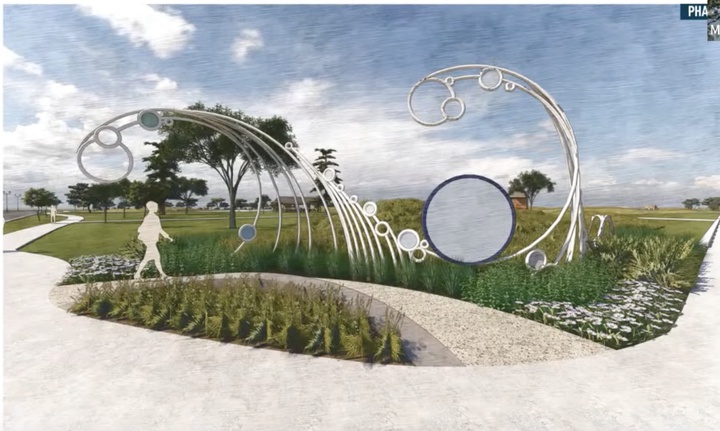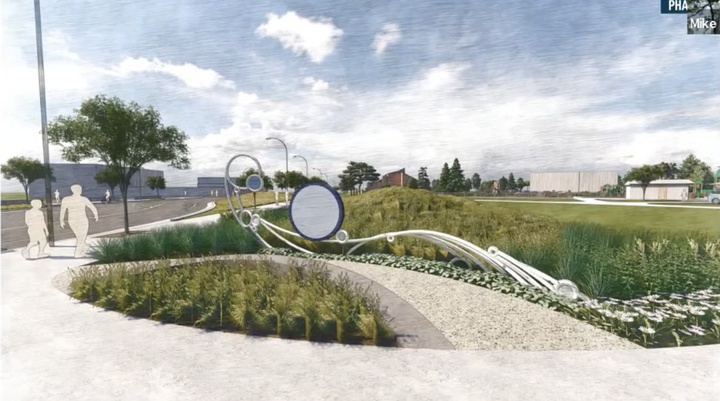Jessica Cejnar Andrews / Wednesday, March 6, 2024 @ 3:56 p.m.
Crescent City Councilors Take Virtual Tour of Redesigned Beachfront Park; Construction on Bike Pump Track Slated To Start This Fall

This concept art shows the tubular steel waves acting as the new gateway to Beachfront Park. | Greenworks Design
Crescent City councilors on Monday took a virtual tour through a Beachfront Park that embraces the community’s relationship with water, sand and forest.
With the team at Greenworks Design playing tour guide, councilors entered the park through tubular steel waves towering 12-15 feet above Stamps Way and Front Street. They explored Kamome Plaza, which features a recreated 20-foot fishing vessel, and an expanded KidTown with its custom-built redwood tree youngsters can climb on, crawl under or slide through.
Councilors saw what the amphitheater and waterfront plaza would look like, wended their way through the Tolowa Interpretive Trail and garden and wound up on the west side of the park, which will house the new bike pump track.
“This is an area we’re getting particularly excited about as construction is anticipated this fall,” said Anya Moucha, a landscape designer for Greenworks Design. “We’ve heard excitement from the community on this pump track, which uses body movement instead of pedaling to get through these rollers and turns.”
Moucha and her colleagues Mike Abbaté and Paul Agrimis have completed 60 percent of Beachfront Park’s big redesign. Their work includes a partnership with Sea Reach Ltd. and members of the Tolowa Dee-ni’ Nation, Elk Valley Rancheria and the Tolowa Nation to remind visitors of Crescent City’s original inhabitants.
Their 60 percent design presentation comes a little more than a year after councilors approved the park’s general development plan outlining how Crescent City would use the roughly $8 million in Proposition 68 grant dollars it received in 2021 and 2022.
Agrimis noted that Greenworks’ design expands beyond the park boundaries to S curves at U.S. 101. It also incorporates a remodeled Cultural Center that houses the Crescent City-Del Norte Chamber of Commerce, Redwood National and State Parks and the Redwood Parks Conservancy.
“One of the things we want to do is capture more of the people who are driving through Crescent City — to get their attention and direct them to the park,” Agrimis told councilors. “As Beachfront Park is transformed, according to this general development plan, it’s going to become a regional feature. There’s too much beauty and grandeur in the surrounding area. We’re capturing some of that and we want to direct people to enjoy it.
Referring to the city’s Gateway Project — funded through $3 million in Clean California Grant dollars — Agrimis said the design evokes the region’s rolling sand dunes starting at the S Curves.
Dunes give way to waves at the park entrance and throughout its 35 acres. The aluminum waves arcing above Stamps Way is complete with bubbles evoking seafoam and has two larger bubble-like circles that will eventually become welcome signs, according to Abbaté.
Waves undulate along the pavement through Kamome Plaza, which tells the story of Crescent City’s sister city relationship with Rikuzentakata, and act as a barrier between the plaza and KidTown.
The dolphins that play along the path leading from the Plaza to the playground, along with the boardwalk material of the path itself, remind visitors that they’re on the coast, Moucha said.

The sculpture is meant to evoke waves crashing on the beach, said Greenworks representative Mike Abbaté. | Greenworks Design
“We started this off with the setting of Crescent City from the redwoods to the coast through the sea and you’ll see each of those elements in this playground design,” she said. “The forest area in this zone will have a subtle berm and pathway that leads you up to the iconic centerpiece of the playground, which is this custom redwood tree.”
There will be a sand play zone nestled and a “sea of rubber” with elements and play equipment related to the ocean, according to Moucha.
“It was important for us to think about accessibility in this design,” she said. “All the paths and routes are fully accessible. There will be different zones for kids with different desires, navigation paths, musical instruments and a large lawn area that’s fully fenced in for unstructured play.”
The amphitheater features a flexible stage set-up that could include a cover. There’s a sloping lawn for the audience and a berm that provides a more elevated view.
The nearby waterfront plaza provides places for merchants to anchor tents against the wind as well as another lawn area and tiered spaces for sitting.
The Tolowa Interpretive Trail features a garden with edible, medicinal and native plants. Its “interpretive nodes” include a redwood tree that’s made to scale to show how massive the real trees are. This one will be constructed of aluminum fins that enclose the viewer while maintaining visibility in all directions, according to Moucha.
Other “interpretive nodes” include a burden basket and a fish and canoe. All the nodes allow visitors to hear local stories of the Tolowa people, she said.
Councilwoman Kelly Schellong was excited about the hollow redwood tree, saying she played in a hollow tree at Beachfront Park as a little girl. But she said she had reservations about how the Tolowa garden would be maintained.
Schellong also asked if aluminum would hold up given the area’s marine climate, how the region’s logging and fishing industry would be incorporated into the park’s design and if there would be an opportunity to provide an opinion and ask for changes on the wave design at its entrance.
“I just haven’t seen it before, so for me it’s new,” she said. “I am uncomfortable with being told this is it when we haven’t had an opportunity to weigh in.”
Though he said he was open to comments, Agrimis said with 60 percent of the design finished, he and his colleagues are working on refining the existing concept. The designs the Greenworks team presented to the City Council on Monday is the fifth or sixth iteration of various concepts they’ve created for the entryway.
“At some point we need to call it good,” he said. “We value input, but at a certain point, decisions have to be made. We’re close to that point where we got to call it good.”
The Tolowa interpretive garden will be made up of native plants that don’t require mowing or much maintenance, Agrimis said.
City Manager Eric Wier said the city has used anodized aluminum for hand rails at its wastewater treatment plant, which is at the end of B Street and is “one of the most corrosive environments you can find.”
“Those handrails have held up since the '70s and they’re still in great shape,” he said.
In addition to the $8 million Prop 68 grant and $3 million Clean California Grant, Crescent City is using $200,000 from the California Coastal Conservancy and $275,000 from the Del Norte Healthcare District.
CLICK TO MANAGE